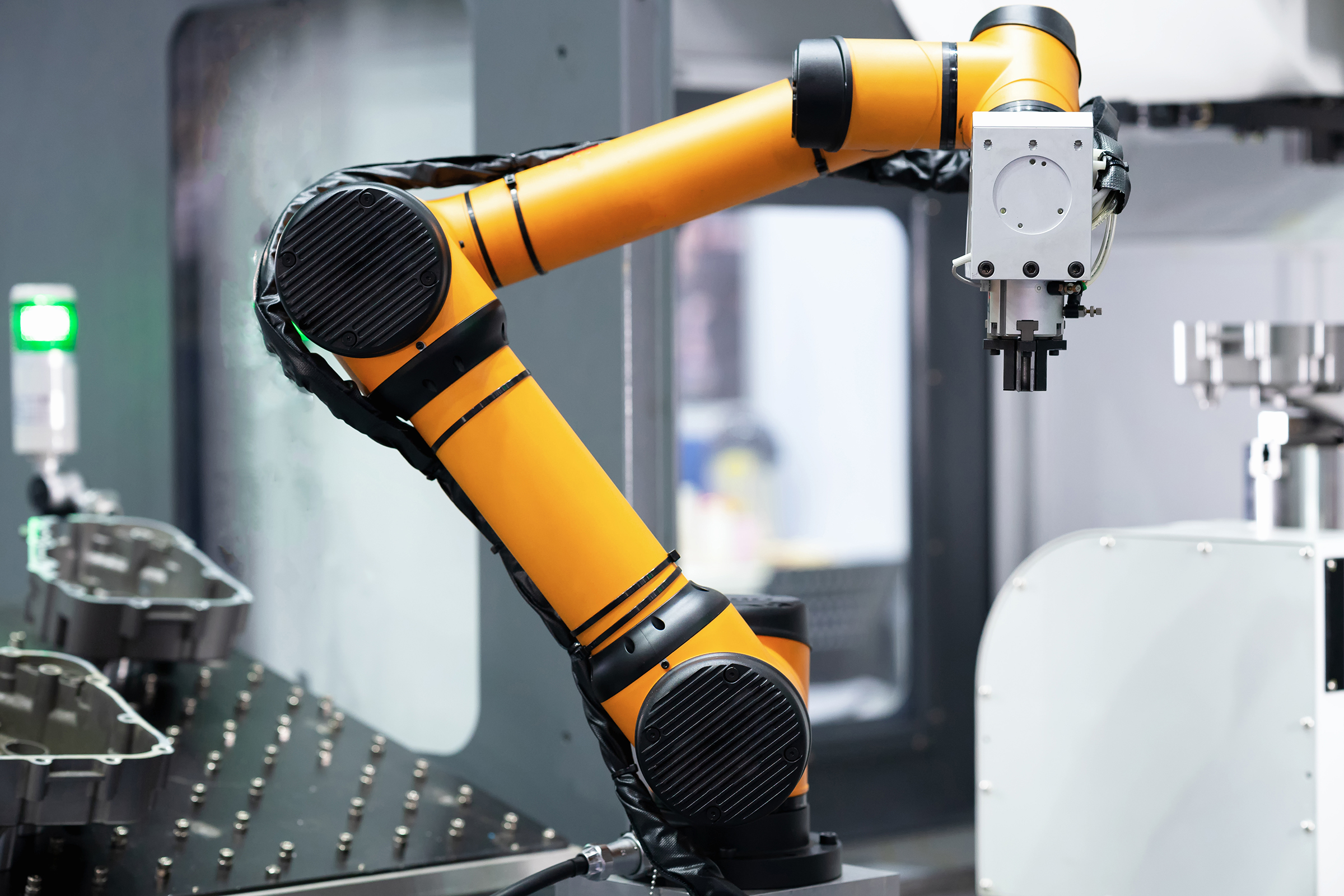Automation
Accelerate your innovation with modern Automation technology.
Business Process Automation (BPA) is designed to automate multiple elements of an end-to-end process. BPA can also help businesses model, optimize, and orchestrate their workflows.
Robotic Process Automation (RPA) empowers you to enhance your workforce by handling repetitive tasks, processing data from unstructured documents, and engaging with intelligent chatbots through text and voice interactions. Business Process Automation (BPA) is designed to automate multiple elements of an end-to-end process. BPA can also help businesses model, optimize, and orchestrate their workflows
- Enhance Productivity: Streamline operations by transferring repetitive tasks to always-on bots, allowing employees to dedicate more time to innovation.
- Accelerate Time to Value: Efficiently develop, test, and deploy new automation strategies within hours, rather than days or months.
- Mitigate Human Error: Attain greater accuracy in data and reporting, enhancing future process efficiencies and ensuring compliance.
- Increase Throughput: Complete automated tasks in seconds or minutes, ensuring swift and reliable execution.
Benefits
Improve Customer Satisfaction and Reduce Manual Work Foster Business Growth. Automat routine manual tasks and redirect employees towards revenue-generating activities
Increase productivity by transferring repetitive tasks to perpetually available bots, allowing employees to allocate more time to innovation.
Speed up the time to achieve value by crafting, testing, and implementing new automation strategies within hours, rather than days or months.
Enhance throughput by completing automated tasks round the clock within seconds or minutes.
Expand your business and realize cost efficiencies by automating routine manual tasks, thus enabling the redirection of employees towards higher-revenue endeavors.
Minimize human error by obtaining more precise data and reporting, which can be utilized to enhance future process efficiencies or ensure compliance.
Our Business Partners In Automation
IT Automation
Reduce Manual Labor and Increase Efficiency across infrastructure
Observability Platform
Deliver continuous high-fidelity data at 1-second granularity and end-to-end traces
Process Mining
Fix process inefficiencies and maximize automation outcomes
Workflow Automation
Increase visibility, consistency, and agility.
Document Processing
Extract document information and process using AI
Digital Workforce
Intelligent Chatbots powered by LLMs and automated self-service integration with all channels and seamless integrations
RPA
Automated processes builders with easy-to-use designers for departmental automation
Content Services
Accelerate content management and governance processes
Enroll for
Use Cases & Industry
Dive into the Automation use cases by Industry to learn about industry-specific solutions. Our Industries Page is a gateway to discovering how we impact businesses across various sectors. Explore the depth of our expertise, tailored services, and success stories that showcase the transformative impact we bring to different industries. Read the following Automation success stories to see how our chosen technologies are used to create maximum value.
Expertise on call
Humana, a major US insurance provider, needed to improve their customer service for healthcare providers. Their legacy IVR system was costly and inefficient, transferring many calls to human agents. They partnered with IBM Watson to develop a conversational AI assistant that could answer routine questions and provide accurate information. The solution, Humana's Voice Agent with Watson, has been a success, reducing costs, improving response rates, and providing valuable insights.
Reliability and Innovation with IBM Observability by Instana
ExaVault Inc., a file transfer solutions provider for companies like Disney and Adobe, handles two billion file transfers annually. Its API manages 35,000 requests per minute, supporting automated, system-to-system transfers crucial for customer decision-making. After adopting IBM Observability by Instana, ExaVault achieved a 56.6% reduction in mean time to resolution, reached 99.99% availability, and gained user-friendly visibility for quicker issue resolutions.
Rapid Report Production with RPA Integration
Deloitte leverages IBM Robotic Process Automation (RPA) to streamline key reporting processes, reducing report production time significantly. The RPA bots seamlessly integrate with SAP, enabling automated data transfer without manual entry. Employees, initially concerned about job displacement, find the automation liberating, allowing them to focus on more rewarding tasks. Deloitte's RPA deployment achieves remarkable efficiency gains, completing tasks like monthly management reports etc.
Strategic Automation at Credigy
Credigy, in collaboration with RPA consultants, strategically prioritized automating business processes to enhance efficiency. They focused on areas like data file management, vendor invoice processing, and due diligence, optimizing tasks to save time and improve accuracy. The goal is to establish a long-term RPA center of excellence, fostering a seamless integration of automation for maximum value and empowering employees to concentrate on creative and strategic aspects.
50% Back-Office Operations Reduction with RPA
Cobmax successfully reduces back-office operations by 50% through the implementation of RPA, enabling employees to acquire new skills and transition to roles in sales, customer support, marketing, and IT. Clients also benefit from decreased errors, faster report turnaround times, and increased satisfaction. The company's agile response to the COVID-19 pandemic highlights the importance of automated processes in maintaining connectivity and efficiency.
Resources
What is RPA?
Learn how RPA helps businesses automate tedious repetitive tasks by an office use case example.
Instana Quick Overview
Learn about automated monitoring of application performance, infrastructure, service, distributed tracing etc.
Workforce Scheduling
Learn more about our workforce scheduling solution, its features, and the benefits it brings to organizations.

Carhartt
In their vision of replenishment optimization, the speed of turning insight into action is the real game-changer, and the way to get there is through the intersection of AI and robotic process automation (RPA).

MNG Kargo
MNG Kargo chose IBM Cloud Pak for Business Automation to create automated business workflows and implement a new document management system. The solution has improved customer satisfaction, prevented fraud and enhanced invoice reporting capabilities.

Sicoob
Sicoob proves that time is money. Using IBM Robotic Process Automation technology, the credit union system reduced process times up to 80% and cut costs up to 20%.

Deloitte
To speed up the production of key management reports, Deloitte-Brazil deployed the AI-driven IBM Robotic Process Automation tool to automate repetitive work. Automation also freed up valuable time for Deloitte professionals to focus on more high-value work.

BlueShore Financial
With help from intelligent content and process automation experts VersaFile, BlueShore Financial deploys IBM Cloud Pak for Business Automation software, saving CAD 300,000 per year by going paperless and increasing lending volume 250% over three years.

Kyocera Corporation
KYOCERA Global teamed with IBM to double production and expand sales through factory automation.
Visit Cresco's
Featured Blogs

Predictive Auditing and Auditing Automation
FAQs
Traditional automation typically involves complex integrations and coding, while RPA allows for quick and easy automation of repetitive tasks by mimicking human actions through a user interface without the need for extensive coding.
RPA can increase efficiency, accuracy, and scalability of business processes, reduce operational costs, improve compliance, and free up human employees to focus on more value-added tasks.
RPA can automate a wide range of repetitive, rule-based tasks such as data entry, invoice processing, report generation, customer service inquiries, and more.
RPA implementations can be secured through encryption, access controls, role-based permissions, and audit trails to ensure data integrity and compliance with security standards.
Some popular RPA tools include UiPath, Automation Anywhere, Blue Prism, and WorkFusion.
RPA can integrate with existing systems and applications through APIs, web services, and application adapters, allowing bots to interact with various software platforms and databases.
The implementation process typically involves identifying automation opportunities, selecting suitable processes for automation, designing workflows, developing and testing automation scripts, deploying bots, and monitoring performance.
Success metrics for RPA implementation may include cost savings, productivity gains, error reduction, cycle time reduction, compliance improvements, and employee satisfaction.
Common challenges include process complexity, change management, governance issues, scalability limitations, and bot maintenance. These challenges can be addressed through proper planning, stakeholder engagement, training, and ongoing support.
While RPA focuses on automating tasks through software robots that mimic human actions, Process Automation encompasses a broader range of automation technologies, including RPA, Business Process Management (BPM), and workflow automation.
Businesses can identify processes for automation by evaluating criteria such as volume, frequency, rule-based nature, potential for error reduction, and impact on business outcomes.
The implementation process typically involves process analysis, design, development, testing, deployment, and ongoing monitoring and optimization.
Process Automation can integrate with existing systems and applications through APIs, web services, database connections, and middleware, allowing for seamless data exchange and workflow orchestration.
Success metrics may include cost savings, productivity gains, error reduction, cycle time reduction, compliance improvements, customer satisfaction, and employee engagement.
Challenges may include resistance to change, complexity of integration, data security concerns, scalability issues, and selecting the right automation technologies. These challenges can be addressed through effective change management, stakeholder engagement, security protocols, and careful planning.
There are two interpretations:
- Outsourcing: Hiring an agency to create and manage your Amazon store, giving them a share of your profits.
- Software Automation: Using tools to automate repetitive tasks within your existing Amazon business.
Software automation offers more control and keeps your profits, while outsourcing requires less initial effort but comes with cost-sharing.
Streamlining accounts payable processes by automating tasks like invoice processing and payment.
Several options exist, so comparing features and pricing based on your specific needs is crucial.
Using technology to automate repetitive tasks within a business process, improving efficiency and accuracy.
Business automation is a broader term encompassing process automation, while BPA focuses specifically on automating workflows.
The “best” option depends on your specific needs and budget. Research and compare features offered by different solutions.
Automating tasks like data entry, report generation, customer service inquiries, and more.
Several RPA tools exist, with popular options like UiPath, Blue Prism, and Automation Anywhere. Choosing the best option depends on your needs and budget.
Invoice processing, accounts payable automation, expense reporting, and more.
Onboarding new employees, payroll processing, and managing benefits.
It takes RPA beyond basic automation by integrating AI, machine learning, and other advanced technologies for more complex tasks.
The RPA industry is expected to experience significant growth in the coming years due to its potential to improve efficiency and cost savings.
Automating tasks within your organization to improve efficiency and productivity.
Software used to automate tasks related to invoice processing, like receiving, managing, and approving invoices.
UiPath, Blue Prism, Automation Anywhere, and Microsoft are some of the leading RPA companies.


